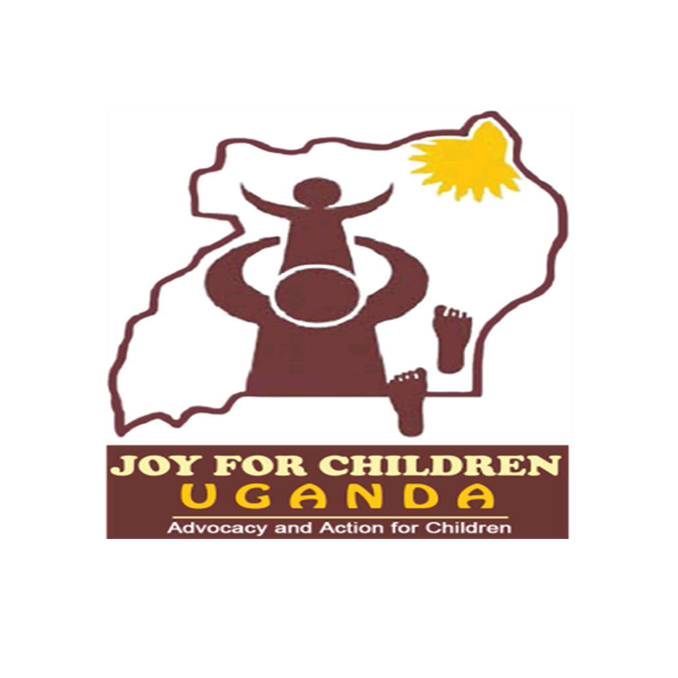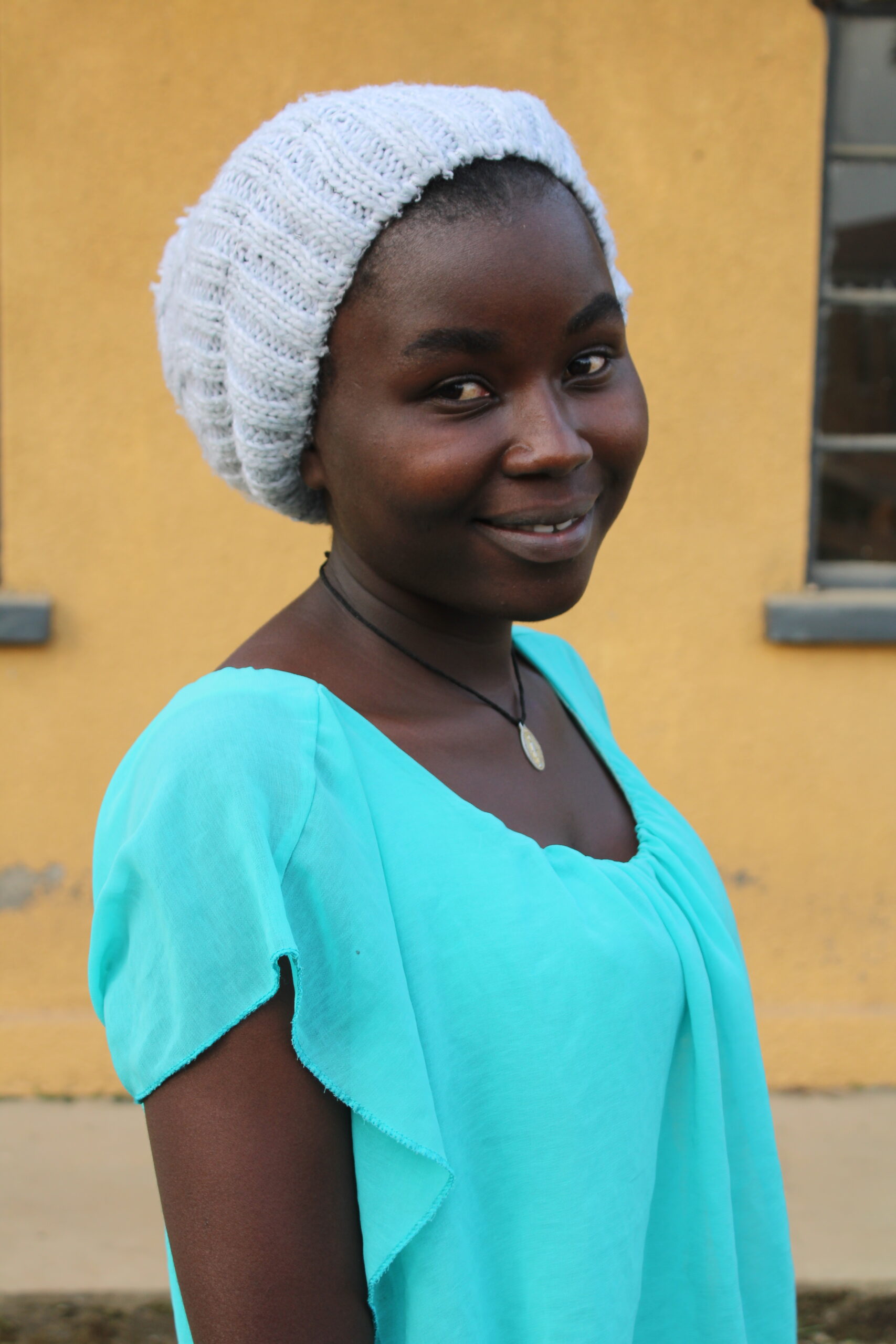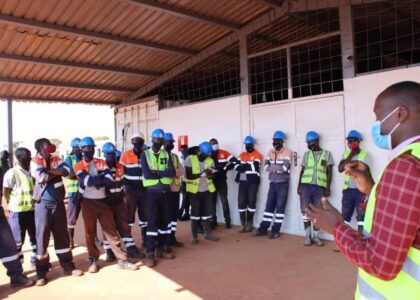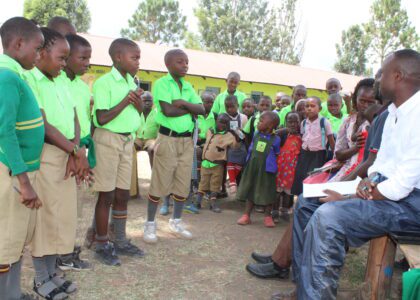Due to poverty, gender discrimination, poor parenting and lack of knowledge, 25% of adolescent girls in Uganda are currently pregnant or have already given birth to their first child. Teenage pregnancy has various negative impacts like severe health complications and early school drop out of girls. A heated debate currently takes place in Uganda on how to address the alarmingly high teenage pregnancy rate.
The area is muddy and dreary; it has rained heavily the previous night. And as always during rainy season, the slum has been flooded. Water has entered the huts which can be dangerous, especially for children sleeping on the floor. Life is not easy in Kampala’s slum areas. But still, population is growing as people from remote rural areas are moving to Uganda’s capital city Kampala looking for a source of income. Esther (name changed) is one of them.
The 19 year old left her home village and found a job at one of the stalls along the roadsides of Bwaise slum. She sells fruits and vegetables and the lady who owns this small business has become like a second mother to Esther. “If I had known her earlier, I would have never made so many mistakes”, Esther says.
Esther’s story is similar to what many teenage mothers in Uganda have gone through. Her parents separated when she was still very young, she grew up with her father who was a soldier. Esther doesn’t know in which conflict or war he died, she just remembers that she was eight years old when her father did not come back from one of the missions he had been sent to. Suddenly, there was no money for schools fees anymore. Her elder sister got married early – she was only 16 years old, but found a husband who could provide for her.
And Esther’s younger brother could stay with their mother. While her mother paid for the boy’s school fees, there was no one who could support Esther. She dropped out of school after only four years of primary school and started working as a housemaid. The family she worked for was friendly and even offered her to go back to school using a part of her income to pay for school fees. But Esther could not manage doing all the house work and attending school at the same time.
Instead, she sent some money home and enabled her mother to build a small mud hut in the village. Esther was 14 years old when she fell for the neighbour’s son. At the age of 15, Esther gave birth to her first child. As the father of the baby did not care about her, Esther moved back to her mother. But soon, her mother had difficulties supporting Esther and her baby with the little money she earned from farming and Esther had to look for a job. While the baby stayed with its grandmother, Esther moved to her cousin’s place in Kampala.
Esther’s cousin earned a living by prostitution. She told Esther that there were no other options for girls like them. Esther joined her to night clubs and bars but she could not stand selling her body to strangers. This was the time when she met her second boyfriend and got pregnant again.
Her daughter is now 2 years old and lives with Esther in Bwaise. Esther is happy that she finally found the job at the food stall and in particular, that she got to know Annah (name changed), the owner of the stall. Annah has become the mother Esther had never had. She takes care of Esther and her little daughter and she introduced Esther to Charlotte, the social worker of Joy for Children Uganda (JFCU).
JFCU has formed women groups in four of Kampala’s slum areas and recently, in Bwaise slum, Charlotte has established a teenage mothers group as well. Young women like Esther meet once a week, share their experiences and receive trainings. Esther is proud that with the help of Charlotte she has learned how to read and write. Also, she has gained knowledge about hygiene, nutrition, family planning and parenting. When she looks back, she regrets that she did not continue with school and got pregnant twice, she wants to share her experiences with other girls and tell them how important education is. She knows better now.
COMBINATION OF POVERTY AND GENDER DISCRIMINATION
Teenage pregnancy is a widely recognized problem in Uganda. The newest Demographic and Health Survey published in March 2017, indicates the teenage pregnancy rate at 25% (UDHS 2016). This means that 25% adolescents age 15-19 in Uganda have begun childbearing. As expected, the rate is higher in rural than in urban areas (27 versus 19 percent, respectively) due to lower levels of education and higher poverty rates in rural areas.
The causes of teenage pregnancy are diverse and Esther’s story illustrates some of them: poor parenting, poverty and gender discrimination.
With a fertility rate of 5.4 (UDHS 2016), Ugandan parents have to take care of averagely more than five children. Especially in rural areas, this responsibility is often left with the mother alone who at the same time works in the fields and does the entire house work (all three duties are seen as women’s issues). Feeling neglected or even being abused at home combined with a lack of parental guidance are major reasons why girls are easy targets of young men who are often just looking for fun. The Ugandan government is aware and concerned about this problem, that’s why the Ministry of Gender, Labour and Social Development has recently developed parenting guidelines to educate parents about their roles and responsibilities. How effective these trainings will be, remains to be seen.
However, it is not only guidance that children need; it is also money for food and school requirements. Most parents in Uganda are struggling to pay school fees and when the income is low, the boy child is send to school. It is a mixture of poverty and gender discrimination; first, there is not enough money to pay for school fees and second, due to the Ugandan tradition of bride price, marrying off girls is a source of income. A 15 year old girl during a Girls Camp organized by Joy for Children Uganda explains: “They (our parents) see in us the cows, the goats and the sugar… Who wants to educate a goat?” While teenage pregnancies lead into child marriage; vice versa child marriage is another cause of the high teenage pregnancy rate in Uganda. 40% of women 20-24 years old are married before the age of 18 (UNICEF 2016).
Teenage pregnancies have various negative impacts. The bodies of young girls are often not prepared for pregnancy and childbirth. That is why Esther had to deliver by caesarean section. However, she was lucky that she did not experience further health complications. About 2,000 new cases of fistula are registered in Uganda annually (UNFPA 2014).
An obstetric fistula is a hole between the vagina and rectum or bladder that is caused by prolonged obstructed labor, leaving a woman incontinent of urine or feces or both. Fistula can be avoided by delaying the age of first pregnancy and timely access to skilled health care. And according to the recent Uganda Demographic Health Survey, 17% of girls age 15-19 die in Uganda during pregnancy or while giving birth (UDHS 2016).
In addition to severe or even deadly health complications, teenage pregnancy results in early school drop out of girls. Without support from parents and teachers, pregnant girls and teenage mothers cannot continue with school which limits their chances of gaining skills and knowledge necessary for finding employment; instead they are often trapped in a vicious cycle of poverty.
EMOTIVE TERM: COMPREHENSIVE SEXUAL EDUCATION
Although teenage pregnancy is recognized by government and civil society as a problem in Uganda, there is no coherent strategy in place to address this issue. The National Strategy to End Child Marriage and Teenage Pregnancy in Uganda which was launched in 2015 mainly focuses on child marriage and does not specifically approach teenage pregnancies.
The East African Legislative Assembly (EALA) – an organ of the East African community – has come up with a draft sexual and reproductive rights bill which intends to provide a framework to prevent unwanted pregnancies, risky abortions and sexually transmitted diseases like HIV and to ensure quality sexual reproductive health care, education and services for all citizens of the East African community. But this bill is highly controversial and led to heated debates in various member states like Tanzania and Uganda.
One of Uganda’s most popular newspapers, the Daily Monitor, published an article in March 2017 with the headline “EALA Bill seeks to introduce contraceptives for children”. The widespread fear is that if children (including adolescents below 18 years) access information about contraceptives, they might feel encouraged to have sex. Children are innocent and the only information they are supposed to need – according to the general public opinion – is that having sexual intercourse too early is dangerous and therefore, they should abstain until they are old enough to get married. In October 2016, the Ministry of Gender, Labour and Social Development released a ban on comprehensive sexual education in schools.
Since then it is difficult for civil society organizations who don’t share the public opinion to continue with their sexual and reproductive health education programmes in schools. There are Ugandans who think differently, mainly social workers and health practitioners who work closely with young people and hence are aware that adolescents already know a lot about sex without any adult telling them and that the information they have is often mixed with misconception which results in risky behavior. That is why they think girls and boys should have access to correct information which allows them to make informed decisions regarding their sexuality.
The discussions will continue on how to address teenage pregnancies and hopefully, Uganda will come up with its own strategy which does not only take into consideration widespread fears and concerns, but also addresses the need of adolescents and leads to a significant reduction of teenage pregnancy rates.





